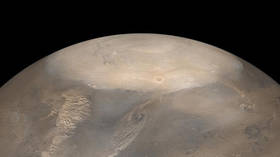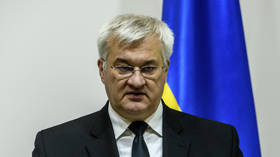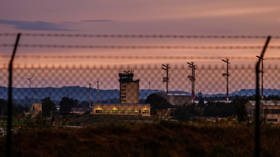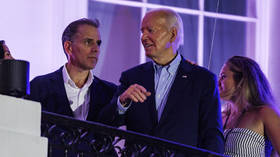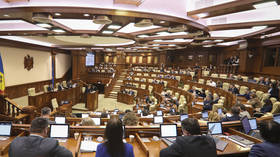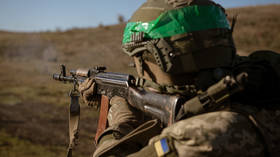Once he recovers from Covid-19, PM Mishustin faces new ordeal – reviving economy & Kremlin’s popularity with thinning oil kitty
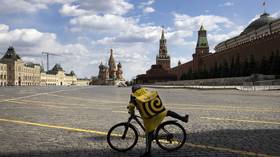
May 1 marked 100 days since Prime Minister Mikhail Mishustin took over the Russian government – and the job he now faces has grown a magnitude harder than the one he accepted.
Any plans he might have drawn up, have been thrown into disarray by the double whammy of crises he is now called upon to cope with – the worst since 1998.
Not a crisis-management hire
When the pandemic struck, Mishustin was still in the middle of reforming his team, and focused on a technical task: implementing the 12 national projects, not dealing with an economic meltdown. Ministers who performed badly when it came to implementing their policy goals have been sacked, and a new crop of bureaucrats was installed to take over. Mishustin drew heavily on his former colleagues from the tax service, which he ran to great effect for a decade.

However, these people do not necessarily make the best HR choices when it comes to crisis management. Their skill has been to fine-tune the machinery of government to make it work more efficiently. The policies now needed are about squeezing an extra 5 percent of revenues out of VAT payments, not shock actions to put a floor under the collapse and reverse the fall.
The new government has not been marked by any significant failures, but it has not scored any noticeable successes either. Indeed, as Russia approaches the peak of infection rates – the number topped 100,000 with a record one-day increase of 7,933 on May 2, and total deaths of 1,169 – Mishustin himself has been infected and withdrew to self-isolation just as the long May Day holiday began.
The government has had to shift ground from the slow build of reconstruction to emergency mode. But it has been doing that very cautiously indeed. President Vladimir Putin has attempted to distance himself from the emergency, and only reluctantly cancelled the referendum on changes to the constitution that could extend his time in office by another two terms.
Also on rt.com ANOTHER Russian minister diagnosed with Covid-19, after PM ends up in hospitalPutin is afraid the nationwide vote, now slated to happen sometime in the summer, could be turned into a referendum on his ability to deal with the public health crisis. And that could go badly wrong. Consequently, he has pushed the responsibility for dealing with the crisis onto regional governors, who have put in a mixed showing so far.
Covid-19: a job for the governors
But even this political damage-control move has already cost Putin politically. More Russians approve of local officials’ coronavirus-response efforts than they do of those initiated by the president and the federal government, according to a newly published survey from the Levada Center.
While 50 percent of the independent pollster’s respondents said they considered their governor or mayor was doing their best to deal with the outbreak, 46 percent said the same of Putin and the government.
Russians’ disapproval was nearly evenly split, with 48 percent disapproving of Putin’s and the government’s response, and 45 percent expressing dissatisfaction about their governor or mayor, according to Levada’s results, released on April 30.
Among Putin’s critics, 18 percent called his measures excessive and 30 percent said they were insufficient. Among critics of the regional leaders, 15 percent said they took excessive steps and 30 percent said those steps were not rigorous enough.
Also on rt.com Poll: Russians split down the middle on presidential terms reset as Putin’s approval rating fallsThe decision to pass the buck is a continuation of the growing reliance on regional governors since the presidential election in 2016, when Putin was returned to office by a landslide. Because the federal-level political machine, in the form of the ruling United Russia party, is increasingly ineffectual, the president turned to the governors to deliver on the vote, but that involved devolving more power to the periphery. The governors have used this increase in responsibility to good effect, taking some of the credit for the changes that got Putin re-elected. As a result, they are now almost as popular with the people as Putin himself.
That’s a problem for Mishustin, as the government and the Duma remain among the most unpopular institutions in Russia. Trust in Putin was already falling in February before the double-headed crisis hit, although his personal popularity remains high.
Mishustin himself is still enjoying the benefit of the doubt among the population, as he came to the top job a relative unknown. Pollsters posted popularity rankings for the prime minister for the first time in February and found the former head of the tax service debuted with just a 3 percent trust rating.
That compares with the rating of his predecessor and long-time Putin proxy Dmitry Medvedev, who was widely distrusted by the population and had only a 38.9 percent approval rating, according to state-owned pollster the Russian Public Opinion Research Center, just before Mishustin took over.
Billions in the crisis chest
However, presumably, Mishustin will be back at work in a fortnight, and his absence will not be too big an issue – the Kremlin has chosen to go slow on the roll-out of an economic-stimulus plan, while it waits to see just how bad things get. Putin initially suggested a stimulation package of 1.3 percent of GDP, whereas other governments are pledging to spending anything between 5 percent and 20 percent of GDP to reboot their economies. More recent announcements have increased that amount to nearer 5 percent, but the details are not yet clear. Much of it is in the form of guarantees and deferred (not cancelled) tax payments, or simply the re-tasking of existing budget spending plans to sectors such as social support.
For the Kremlin, one of the key considerations is to preserve the US$560bn in reserves it holds and to spend as little of the RUB12 trillion (US$169bn) in the National Welfare Fund as possible, because it’s this fund that buys Russia impunity from international pressure. So, Mishustin’s work for the moment is a technical job of reallocating budget funds to where they will be most effectively spent to stymie the collapse of the economy. The practice of quick deregulations as a means of crisis response, and a prompt, often outside-formal-rules solution to the current difficulties should be something he is good at.
Also on rt.com Russia needs EVEN BIGGER stimulus to fix coronavirus quarantine damage, says ex-finance ministerThere is now a more harmonious co-operation between the government and the Central Bank of Russia (CBR), which will play an important role in counteracting the negative impact of the crisis. Mishustin worked closely with both Finance Minister Anton Siluanov and CBR governor Elvira Nabiullina as head of the Tax Service, so their fiscal and monetary response should be well considered and implemented in concert.
The CBR has already sold its stake in state-owned retail banking giant Sberbank to the Ministry of Finance, which puts an extra RUB2.14 trillion (US$29.1bn) into the state’s war chest. And then the CBR cut 50 basic points off interest rates to 5.5 percent on April 24 to give the economy a growth-boosting shot in the arm. Nabiullina made it clear there will be more rate cuts this year.
A supply-side boost
While the macro-level crisis actions will almost certainly be good – Russia has such a large reserve of cash, and the triumvirate of the Tax Service, Ministry of Finance and CBR, have proven themselves to be so competent – meaning it will hard to screw it up, the really big issue is this: the Kremlin has no plan to support anything other than the country’s macro-position and big business.
The “vertical power” structure Putin has built means the state has good connections with the massive state and privately owned businesses – almost all of which are on the list of 1,151 “strategically important companies” eligible for direct state-aid release on April 30 – it has no real connection to the small- and medium-sized enterprises or the average Russian.
Also on rt.com Handing out free cash to citizens as part of coronavirus relief will lead to hyperinflation in Russia – Central BankAnd it is people and small businesses that are in the firing line in this crisis, unlike in the financial crises of the past, when it was the state and large enterprises that took most of the hit. That is what public health crises do. Lockdowns kill small stores with little in the way of financial reserves, but leave big steel mills relatively unscathed. The most debilitating part of the 2014 crisis, for example, was the margin calls on big companies that almost forced them into bankruptcy. Russia’s biggest companies had borrowed heavily abroad, but used their shares as collateral. When the value of their shares falls below a certain predetermined value, the companies have to pay out the difference in cash – a margin call – and they were forced to come up with hundreds of millions of dollars at short notice at a time when the banking system was effectively closed.
One option to deal with this problem is for the Kremlin to pump cash into the economy and put it directly into the pockets of the population by hiking public sector wages. Indeed, the boom years of the noughties was driven by the Kremlin’s 10 percent hike in wages every year for nearly a decade. It decided to use the torrents of inbound petro-cash to close the gap between public and private sector incomes or face the possibility of a popular protest resulting from a dual-speed economy. The subsequent consumer binge transformed Russia, doubling the size of the economy, in what was essentially a supply-side boost to growth.
Bracing for a fall in the fall
But the Kremlin cannot afford to do that again. Indeed, the entire economic program Mishustin was hired to implement is driven by a fundamentally different concept – these 12 national projects are a demand-side program.
The budget spending has been increased by RUB3 trillion, from the average of RUB16 trillion of recent years to RUB19.8 trillion for this year, but that extra money is largely earmarked to go into sectors such as infrastructure investment to create economic multipliers that will boost growth. Russia was fundamentally under-investing prior to the crisis, as there is no money spare to direct into public wage hikes for a supply-side bump.
But it could be done. Its total wage bill is currently about RUB6 trillion and if the extra RUB4 trillion of spending were all re-tasked to wages, that would make a difference. However, that would be to completely re-make the Kremlin’s plans for the economy and lead to all sorts of new problems, including a massive spike in inflation. And this is not the job that Mishustin was hired to do.
Also on rt.com Coronavirus to shrink Russian economy by over 5% this year – Moody’sAll these problems are being put off for the meantime. The summer dacha season is about to start, and coronavirus infection rates should peak in the coming weeks, especially as Moscow – which has half the infections in the whole country – has implemented such a strict stay-at-home regime. Mishustin has time to work out what to do and can begin rolling out a more targeted response over the summer.
Nonetheless, the cautious approach by the government means the economic damage will last longer. The biggest long-term consequence is almost certain to be a fall in investment that extends and deepens Russia’s economic stagnation. The forecast of the Bank of Russia for the decline in GDP in the second quarter is 8 percent – and that exceeds the scale of the shocks of both 2008 and 2014, and is comparable to the shock of 1998. And it should be noted that Russia took several years to recover from each of those.
This article also appears in bne IntelliNews.
If you like this story, share it with a friend!
The statements, views and opinions expressed in this column are solely those of the author and do not necessarily represent those of RT.


